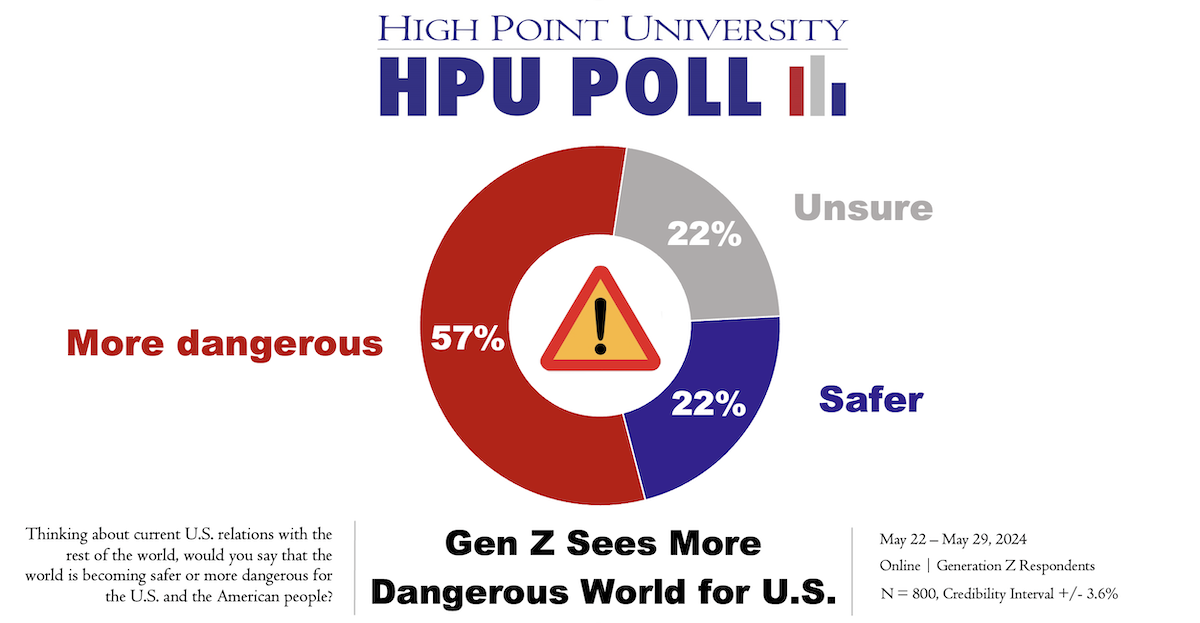Gen Z (43%) and adult respondents (47%) say U.S. should take an “active part” in world affairs.
HIGH POINT, N.C., June 21, 2024 – In the latest High Point University Poll surveys, Generation Z respondents were more likely to see Russia (28%) rather than China (23%) as the single biggest threat to U.S. national security. Meanwhile, U.S. adults see China (36%) rather than Russia (29%) as the single biggest national security threat.
Gen Z and the all-adult respondents differ somewhat on the relative level of threat posed by North Korea. Whereas 19% of Gen Z respondents say North Korea is the single greatest threat, only about one in 10 (11%) of the all-adults sample say so.
Two HPU Poll surveys asked a national all-adults sample (n = 1000) and a separate national Generation Z sample (n = 800, ages 18 – 29) the same questions about foreign policy and national security.
Adults and Generation Z in the U.S. generally agree about the country’s role in the world and the relative level of safety for the U.S. and its people in the international system. More U.S. adults (47%) and Generation Z (43%) say the U.S. should take an active part in world affairs than the one-third U.S. adults (33%) and Generation Z (38%) who say the U.S. should stay out of world affairs.
About two-thirds (65%) of the U.S. adults and more than half (57%) of Generation Z survey respondents see the world becoming more dangerous for the U.S. and the American people.
“While there is a good deal of agreement between these two groups about the role of the U.S. in the world and the danger the U.S. faces, there are some differences in how they see the threats themselves,” said Dr. Martin Kifer, director of the HPU Survey Research Center and chair of HPU’s political science department. “Gen Z is living through an era that is different from the formative years of earlier generations. Their interpretations of U.S priorities will be important for politics and foreign policy in the future.”
U.S. Adults (May 2024)
Now we would like to ask you some questions about foreign affairs issues. Do you think it will be best for the future of the country if we take an active part in world affairs, or if we stay out of world affairs?
Active part – 47%
Stay out – 33%
Unsure – 20%
Thinking about current U.S. relations with the rest of the world, would you say that the world is becoming safer or more dangerous for the U.S. and the American people?
Safer – 16%
More dangerous – 65%
Unsure – 19%
Which of these countries do you perceive as the single biggest threat to U.S. national security? [COUNTRIES PRESENTED IN RANDOMIZED ORDER]
Russia – 29%
China – 36%
North Korea – 11%
Iran – 8%
Some other country – 3%
Unsure – 14%
U.S. Generation Z (May 2024)
Now we would like to ask you some questions about foreign affairs issues. Do you think it will be best for the future of the country if we take an active part in world affairs, or if we stay out of world affairs?
Active part – 43%
Stay out – 38%
Unsure – 19%
Thinking about current U.S. relations with the rest of the world, would you say that the world is becoming safer or more dangerous for the U.S. and the American people?
Safer – 22%
More dangerous – 57%
Unsure – 22%
Which of these countries do you perceive as the single biggest threat to U.S. national security? [COUNTRIES PRESENTED IN RANDOMIZED ORDER]
Russia – 28%
China – 23%
North Korea – 19%
Iran – 7%
Some other country – 5%
Unsure – 18%
HPU Poll 104 comprised two online surveys fielded by the High Point University Survey Research Center on May 22 through May 29, 2024, using panels of respondents recruited and maintained by Dynata. Dynata sent invitations to its panels of U.S. adult respondents and Generation Z respondents and the SRC collected 1,000 total adult responses (18 years of age and older) and a separate sample of 800 Generation Z responses (ages 18 – 29) on its Qualtrics platform. The SRC did all data analysis. The online samples are from panels of respondents, and their participation does not adhere to usual assumptions associated with random selection. Therefore, it is not appropriate to assign classic margins of sampling error for the results. In this case, the SRC provides credibility intervals of plus or minus 3.3 percentage points for the all-adult sample to account for a traditional 95% confidence interval for the estimates (plus or minus 3.1 percentage points) and a design effect of 1.1 (based on the weighting). The SRC provides a credibility interval of plus or minus 3.6 percentage points for the Generation Z sample to account for a traditional 95% confidence interval for the estimates (plus or minus 3.5 percentage points) and a design effect of 1.1 (based on the weighting). The data is weighted toward population estimates for age, gender, race, ethnicity, and education based on U.S. Census numbers for the United States. Factors such as question wording and other methodological choices in conducting survey research can introduce additional errors into the findings of opinion polls. Percentages may not add to 100 because of rounding.
Further results and methodological details from the most recent survey and past surveys can be found at the Survey Research Center website. Materials online include past press releases as well as memos summarizing the findings (including approval ratings) for each poll since 2010.
The HPU Poll reports methodological details in accordance with the standards set out by AAPOR’s Transparency Initiative, and the HPU Survey Research Center is a Charter Member of the Initiative.
You can follow the HPU Poll on X.
Dr. Martin Kifer, chair and associate professor of political science, serves as the director of the HPU Poll, and Brian McDonald is the associate director of the HPU Poll.
